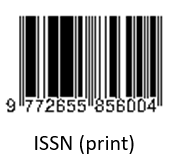Analysis of Blasting Geometry on Blasting Production Results at PT Semen Bosowa Maros
(1) Universitas Muslim Indonesia
(2) Universitas Muslim Indonesia
(3) Universitas Muslim Indonesia
(4) Universitas Muslim Indonesia
(5) Universitas Muslim Indonesia
(*) Corresponding Author
Abstract
Limestone mining for cement plants uses a blasting method to break the material. Blasting production is considered successful when it can achieve production targets based on tonnage of uncovered rock, efficient use of explosives, grain size or rock fragmentation, and environmental impact. This research aims to analyze the blasting geometry on the production results at the research location by knowing the initial design, the actual blasting geometry, and the geometry recommendation using the C.J. Konya method. In addition, researchers also know the explosives used, the production results in the form of material fractionation using the Kuz-Ram method and the tonnage of uncovered rocks. The initial design with a burden of 3.4 m, spacing of 3.4 m, hole depth of 5.9 m, and ANFO explosives per hole of 33 kg produced 147.31 tonnages. The actual geometry with a burden of 1.7 m, spacing of 3.5 m, hole depth of 6.0 m and ANFO explosives per hole of 26.73 kg produced a 77.11 tonnage. The actual geometry resulted in a blasting production of 6,941 tonnes per day, which did not meet the company's production target 10,639. The fragmentation calculation results obtained an average size in the field of 15.29 cm, which meets the required screening or sieve criteria of 0.80 - 1.00 m. The size of the fragments also follows the sieve calculation using the Kuz-Ram method, with a 100 cm sieve passing only 0.01%. Based on this, the company is recommended to make geometry changes to achieve the production tonnage target that has been set.
Full Text:
PDFReferences
R. Susanti and T. A. Cahyadi, Kajian teknis operasi peledakan untuk meningkatkan nilai perolehan hasil peledakan di Tambang Batubara Kab. Kutai Kartanegara Provinsi Kalimantan Timur, in Seminar Nasional Kebumian 2011, (2011).
A. Pomasoncco-Najarro, C. Trujillo-Valerio, L. Arauzo-Gallardo, C. Raymundo, G. Quispe, and F. Dominguez, Pre-split blasting design to reduce costs and improve safety in underground mining, Energy Reports, 8 (2022).
R. M. Bhatawdekar, D. Kumar, S. Changtham, D. Pathak, S. TrilokNath, and E. T. Mohamad, Intelligent Technique for Prediction of Blast Fragmentation Due to the Blasting in Tropically Weathered Limestone, in Lecture Notes in Civil Engineering, (2022).
A. Nurwaskito, R. A. Putra, and A. S. Munir, Analisis Penggunaan Balldeck pada Kegiatan Peledakan untuk Meminimalisir Flyrock, Geomine, 100(2) (2022) 280–291.
S. Ramadana and R. Kopa, Analisis Geometri Peledakan Guna Mendapatkan Fragmentasi Batuan yang Diinginkan untuk Mencapai Target Produktivitas Alat Gali Muat Kalimantan Utara, Bina Tambang, (2018).
Herman, Widodo S, and Waskito AN, Analisis Pengaruh Kedalaman Lubang Ledak, Burden, dan Spacing Terhadap Perolehan Fragmentasi Batugamping, Jurnal Geomine, 3(1) (2015) 184–188.
A. A. Budiman, Analisis Powder Factor Dan Fragmentasi Hasil Ledakan Menggunakan Perhitungan Kuz-Ram Pada Tambang Batubara Di Provinsi Kalimantan Timur, Jurnal Geomine, 4(2) (2016).
H. A. Saputra, S. Widodo and A. Nurwaskito, Analisis Pengaruh Powder Faktor Terhadap Hasil Fragmentasi Peledakan Pada PT Semen Bosowa Maros Provinsi Sulawesi Selatan, Jurnal Geomine, 3(1) (2015).
Z. T. Bieniawski, Engineering Classification of Jointed Rock Masses, Civ Eng S Afr, 15(12) (1973) 90924-3.
S. Saptono, Sistem Klasifikasi Massa Batuan untuk Tambang Terbuka, 1st ed. Yogyakarta: LPPM UPN Veteran Yogyakarta, (2021).
Kementrian ESDM RI, Keputusan Menteri ESDM RI No. 1827 K/30/MEM/2018 tentang Pedoman Pelaksanaan Kaidah Teknik Pertambangan yang Baik, 1(4) (2018).
F. A. Ramadhan, Yuliadi, and N. F. Isniarno, Pengaruh Geometri Peledakan Terhadap Getaran Tanah dan Fragmentasi Batuan pada PT. Gunung Kulalet, Kecamatan Baleendah Kabupaten Bandung, Provinsi Jawa Barat, Bandung Conference Series: Mining Engineering, 2( 2) (2022) 2925.
A. Nurwaskito, Studi Teknis Pengaruh Penggunaan Sekam Padi terhadap Aktivitas Peledakan di PT Semen Bosowa Maros Provinsi Sulawesi Selatan, Jurnal Geomine, 1(1) (2016).
S. A. Vokhmin, A. A. Kytmanov, G. P. Erlykov, E. V. Shevnina, G. S. Kurchin, and A. K. Kirsanov, Prediction and Actual Oversized/Undersized Fragmentation in Underground Blasting, Journal of Mining Science, 57(2) (2021).
M. Z. F. Rahman, Calculation of The Cost of Underground Mining Activities on Tunnel 9 PT. Allied Indo Coal Jaya, Georest, 1(1) (2022).
A. A. M. A. Ansari, V. Seervi, N. Kishore, and N. P. Singh, An Investigation into the Effect of Rain on Fragmented Coal: A Case Study, Journal of The Institution of Engineers (India): Series D, (2023).
N. Slyambekov, Review of the use of advanced technologies in drilling and blasting, Geo-Technical Mechanics, 159 (2021) 108–114.
B. Ke et al., Parameter Optimization and Fragmentation Prediction of Fan-Shaped Deep Hole Blasting in Sanxin Gold and Copper Mine, Minerals, 12(7) (2022).
A. Milwadi, Rancangan Peledakan untuk Memenuhi Target Produksi dan Estimasi Biaya Produksi Peledakan pada PT Semen Bosowa Maros Kabupaten Maros Provinsi Sulawesi Selatan, Universitas Papua, Manokwari, (2017).
S. Dhiyauddin, Teknik Pengamatan dan Analisis Fragmentasi Hasil Peledakan Batuan Andesit Pada Tambang PT. Gunung Mas Jaya Indah, UIN Syarif Hidayatullah Jakarta, Jakarta, (2022).
W. Sundari, Analisis Lubang Ledak dan Geometri Peledakan dengan Menggunakan Metode Anderson untuk Mencapai Target Produksi pada PT. Andesit Lumbung Sejahtera di Desa Bandar Dalam Kecamatan Sidomulyo Kabupaten Lampung Selatan Provinsi Lampung, Jurnal Ilmiah Teknologi FST Undana, 15 (1) (2021) 43–52.
DOI: https://doi.org/10.24071/ijasst.v5i2.6423
Refbacks
- There are currently no refbacks.
Publisher : Faculty of Science and Technology
Society/Institution : Sanata Dharma University

This work is licensed under a Creative Commons Attribution 4.0 International License.











